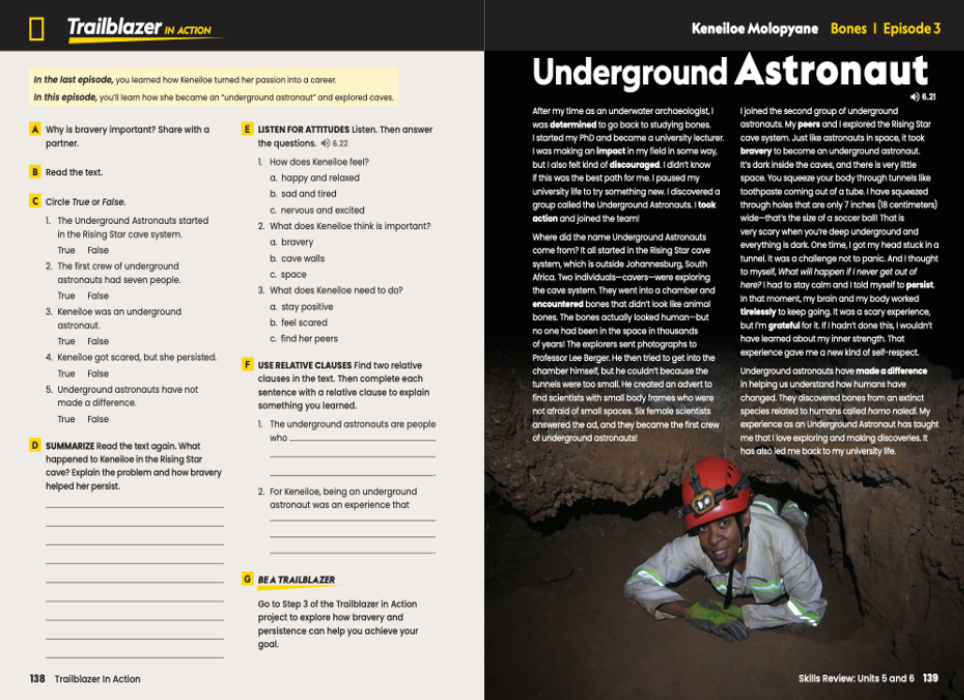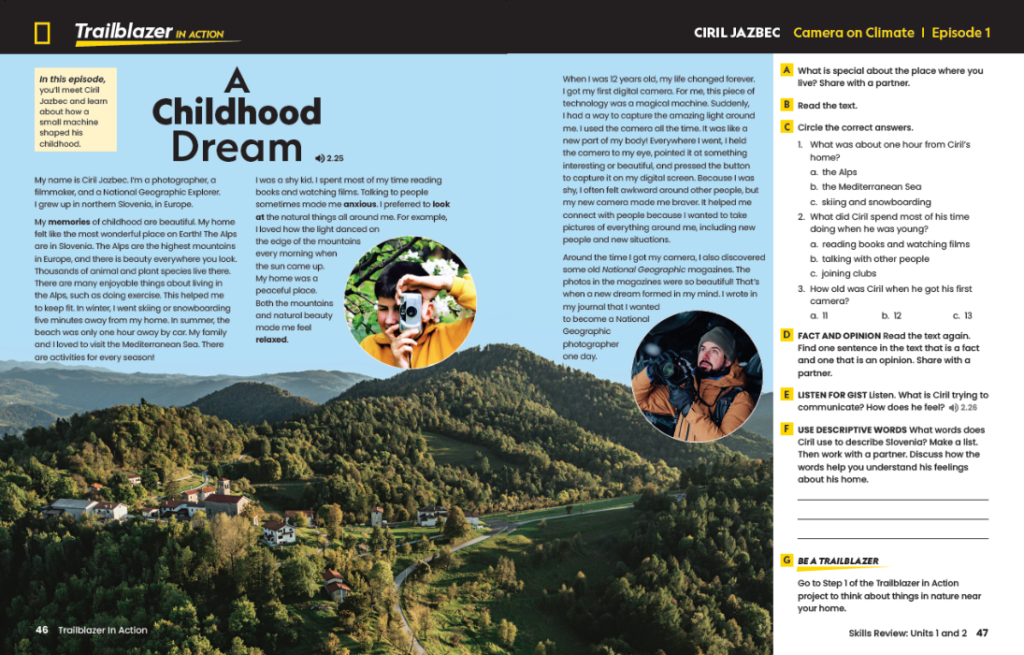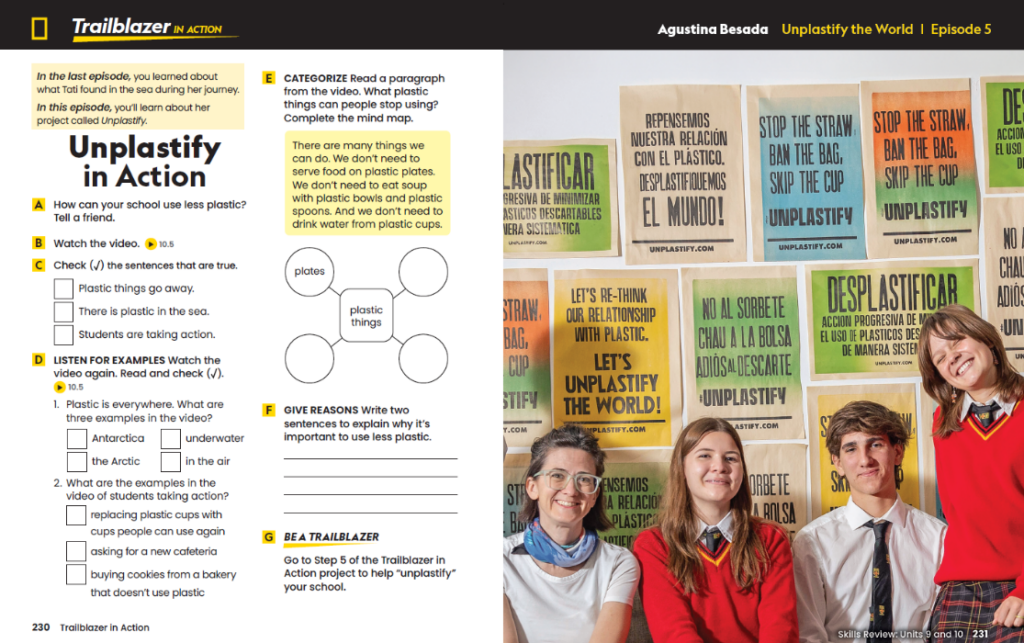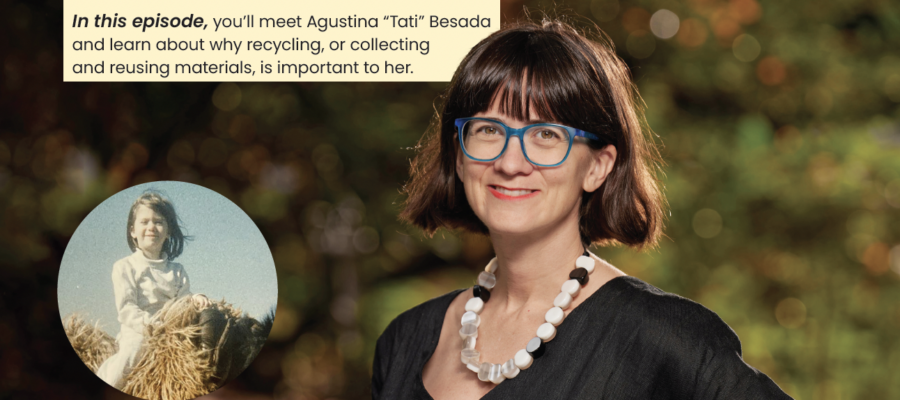For young learners of English, the world is full of wonders waiting to be explored, challenges to be overcome, and lessons to be learned. Finding English language learning content that can bring those wonders into the classroom or finding role models to inspire young learners can be challenging. Who better to inspire young learners than the intrepid National Geographic Explorers?
These impressive people offer glimpses of adventures in different parts of the world, examples of persistence overcoming adversity, and model how to make a difference in the world. As educators, we have a unique opportunity to bring these Explorers’ stories into our classrooms, igniting curiosity, developing grit, and fostering a love for learning in our students. This article shares teaching tips for integrating these remarkable stories into your young learner classroom.
The Importance of Telling Explorer Stories
What difference can the stories of National Geographic Explorers make in our English classrooms and in our students’ lives? Here are a few compelling reasons to consider including these role models:
IDENTIFICATION: Learners can see themselves in aspects of the Explorers’ lives and work, making learning more relatable and engaging.
MOTIVATION: The Explorers’ stories motivate learners to use English to tell their own stories, to share their own opinions, and to gain a deeper understanding of other people and themselves, while also encouraging language use in real-world contexts.
RESILIENCE AND PERSISTENCE: Learning about the struggles and challenges that Explorers face helps learners to understand that failures and overcoming obstacles are a regular part of the journey to becoming successful. Demystifying failure is an essential part of building persistence.
INSPIRATION: Learners are inspired to use English to engage confidently with the world and make a positive impact.
Meet the Explorers
The National Geographic Society chooses Explorers who are trailblazers, change makers and innovators. These people are exceptional individuals in their fields who illuminate and protect our world through their work in science, exploration, education, and storytelling.
The Explorer Mindset
According to the Society, while National Geographic Explorers represent diverse backgrounds and fields of work, they are united by shared values and commitments. National Geographic Explorers …
- are leaders and problem solvers
- are informed, curious, and capable individuals who are committed to making the world a better place
- have a sense of responsibility and respect for other people, cultures, and the natural world
- are empowered to make a difference, pursue bold ideas, and persist in the face of challenges
- observe, document, and engage with the world around them
- tell stories that inspire others
- create and foster a global community committed to a sustainable future
- are committed to supporting diversity, equity, and inclusion in their fields
National Geographic Learning’s new primary series Trailblazer features several National Geographic Explorers, each with their unique stories, in lessons called ‘Trailblazer in Action’. They help young learners gain their own Explorer Mindset. Here are three Explorers from Trailblazer you might want to introduce to your students:
Keneiloe Molopyane
A bioarchaeologist and physical anthropologist, Keneiloe is a real-life Indiana Jones who unearths human stories from the past. Once Keneloe was exploring in the Rising Star caves, crawling through openings only 18 centimeters (7 inches) in diameter, when her head got stuck. She felt herself start to panic, imagining what would happen if she couldn’t get unstuck, but she told herself that she couldn’t panic, that she had to persist. She made it through and continues to document our ancient ancestors.

Ciril Jazbec
A photojournalist, Ciril captures the impacts of climate change through his powerful photographs. Sometimes he makes mistakes. Once he had been invited to join a traditional hunter in Iceland for a dog sled trip. During the trip he made a big mistake. He let go of the ropes holding the dogs so that he could take a photo, and they ran off. He and the hunter were left in a freezing isolated place where it was so cold they couldn’t even cry. The dogs eventually came back, and Ciril was able to finish documenting how climate change was affecting a traditional way of life.
Ariel Waldman
Ariel is an Antarctic Explorer, microscopic wildlife filmmaker, and Global Director of Science Hack Day. When Ariel was a child, she watched a documentary about NASA and the early space program. She was surprised to learn that most people who joined NASA at that time didn’t know anything about rockets. Later she graduated from art school, where she studied graphic design, and now she’s part of the scientific community creating documentaries about tiny lifeforms in Antarctica and working with NASA. She loves that science needs people with lots of different skills and interests.
Teaching Tips: Sharing Explorer Stories
Now that we’ve met the Explorers, let’s discuss how to bring their stories to life in the classroom:
Introduce the Explorer
Start by sharing basic information about the Explorer. Have students discuss or write about what they have in common with the Explorer. This activity promotes empathy and connection. For example, in this episode of ‘Trailblazer in Action’, Ciril Jazbec shares how awkward and shy he felt as a child, and how all that changed when he got a camera at 12 years old. He became more confident and braver. He even wrote in his journal that he wanted to be a National Geographic Photographer when he grew up! Do you think your students would be able to relate to young Ciril?

Share an inspirational moment
Every Explorer has a key moment that inspired them to do the work they do. Share this moment with your students, and discuss how inspiration can come from unexpected places. Sometimes it can even be your favorite TV show. Listen to Keneiloe Molopyane’s podcast about her childhood inspiration.
Highlight achievements
Discuss a significant achievement in the Explorer’s work. This could be a discovery, a project, or a publication. This reinforces the idea that hard work leads to results. Watch this video about Science Hack Day and learn how everyone can be part of amazing solutions!
Explore challenges
No journey is without its hurdles. Share a challenge the Explorer faced and how they overcame it. This teaches students resilience and problem-solving. Even younger children with limited English can engage with the Explorers’ challenges and how they overcame them. Explorers are people too, who keep trying to make a difference, even when it’s hard. In this video, Jahawi Bertolli describes some of the challenges he’s faced in his work as a filmmaker.
Inspire students to ‘be a Trailblazer’
Finally, encourage students to become Trailblazers themselves, discuss how they can apply what they’ve learned in their own lives, and ask them to take action to make a difference—even if it’s a small one, it’s a start. Agustina Besada is taking action against plastic pollution, and she’s helping others to come together, understand the problem, and be part of the solution. Check out her project, Unplastify, in the lesson below!

By integrating the stories of National Geographic Explorers into your young learner classroom, you’re not just teaching English. You’re inspiring a new generation of Explorers, scientists, and storytellers. You’re showing them that the world is a fascinating place, full of challenges to overcome and wonders to discover. And most importantly, you’re teaching them that they too can use English to make a difference in the world.
National Geographic Learning’s Trailblazer program for young learners of English features the real-life stories of National Geographic Explorers, inspiring them to confidently engage with the world and take positive action to make an impact on it.


